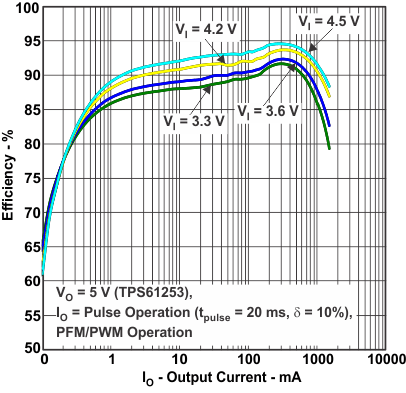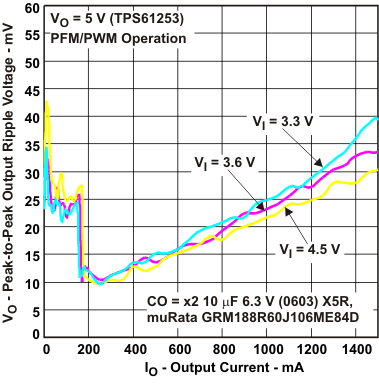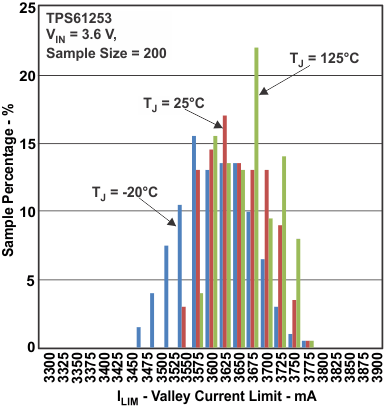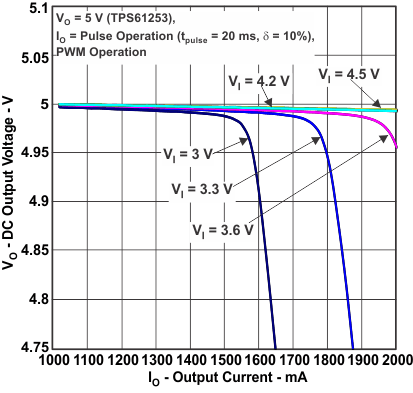-
TPS6125x 3.5-MHz High Efficiency Step-Up Converter In Chip Scale Packaging
- 1 Features
- 2 Applications
- 3 Description
- 4 Revision History
- 5 Device Options
- 6 Pin Configuration and Functions
- 7 Specifications
- 8 Parameter Measurement Information
- 9 Detailed Description
- 10Application and Implementation
- 11Power Supply Recommendations
- 12Layout
- 13Device and Documentation Support
- 14Mechanical, Packaging, and Orderable Information
- IMPORTANT NOTICE
Package Options
Refer to the PDF data sheet for device specific package drawings
Mechanical Data (Package|Pins)
- YFF|9
Thermal pad, mechanical data (Package|Pins)
Orderable Information
TPS6125x 3.5-MHz High Efficiency Step-Up Converter In Chip Scale Packaging
1 Features
- 93% Efficiency at 3.5-MHz Operation
- 21-µA Quiescent Current in Standby Mode
- 37-µA Quiescent Current in Normal Operation
- Wide VIN Range From 2.3 V to 5.5 V
- VIN ≥ VOUT Operation
- IOUT ≥ 800 mA at VOUT = 4.5 V, VIN ≥ 2.65 V
- IOUT ≥ 1000 mA at VOUT = 5.0 V, VIN ≥ 3.3 V
- IOUT ≥ 1500 mA (Peak) at VOUT = 5.0 V, VIN ≥ 3.3 V
- ±2% Total DC Voltage Accuracy
- Light-Load PFM Mode
- Selectable Standby Mode or True Load Disconnect During Shutdown
- Thermal Shutdown and Overload Protection
- Only Three Surface-Mount External Components Required
- Total Solution Size < 25 mm2
- 9-Pin NanoFreeTM (CSP) Packaging
2 Applications
- Cell Phones, Smart Phones
- Mono and Stereo APA Applications
- USB Charging Ports (5V)
3 Description
The TPS6125x device provides a power supply solution for battery-powered portable applications. Intended for low-power applications, the TPS6125x supports up to 800-mA load current from a battery discharged as low as 2.65V and allows the use of low cost chip inductor and capacitors.
With a wide input voltage range of 2.3 V to 5.5 V, the device supports applications powered by Li-Ion batteries with extended voltage range. Different fixed voltage output versions are available from 3.15 V to 5.0 V.
The TPS6125x operates at a regulated 3.5-MHz switching frequency and enters power-save mode operation at light load currents to maintain high efficiency over the entire load current range. The PFM mode extends the battery life by reducing the quiescent current to 37 μA (typ) during light load operation.
In addition, the TPS6125x device can also maintain its output biased at the input voltage level. In this mode, the synchronous rectifier is current limited allowing external load (e.g. audio amplifier) to be powered with a restricted supply. In this mode, the quiescent current is reduced to 21 µA. During shutdown, the load is completely disconnected from the battery. Input current in shutdown mode is less than 1 µA (typ), which maximizes battery life.
The TPS6125x offers a very small solution size due to minimum amount of external components. It allows the use of small inductors and input capacitors to achieve a small solution size.
- For all available packages, see the orderable addendum at the end of the datasheet.
Efficiency vs Load Current
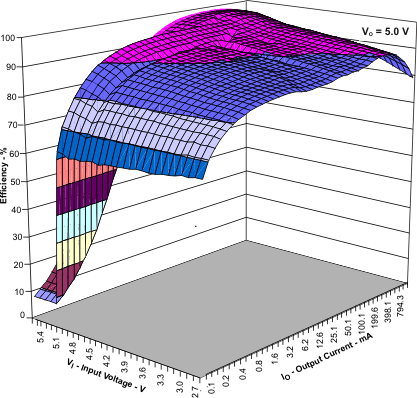
4 Revision History
Changes from F Revision (March 2016) to G Revision
- Changed the Package Dimensions sectionGo
Changes from E Revision (March 2015) to F Revision
- Added device TPS612592Go
Changes from D Revision (December 2014) to E Revision
- Changed Body Size (NOM) from "1.60 mm × 1. 60" to "1.206 mm × 1. 306" in the Device Information table.Go
- Added table note reference to Third-Party Products DisclaimerGo
Changes from C Revision (August 2012) to D Revision
- Added ESD Ratings table, Feature Description section, Device Functional Modes, Application and Implementation section, Power Supply Recommendations section, Layout section, Device and Documentation Support section, and Mechanical, Packaging, and Orderable Information sectionGo
Changes from B Revision (May 2012) to C Revision
- Added TPS61259 to data sheet header as production device.Go
- Changed device TPS61259 to production statusGo
Changes from A Revision (October 2011) to B Revision
- Added TPS61253 and TPS61258 to data sheet header as production devices.Go
- Changed devices TPS61253 and TPS61258 to production statusGo
- Changed graphic entity for Figure 3Go
- Changed graphic entity for Figure 10 and Figure 13Go
- Changed graphic entity for Figure 23Go
Changes from * Revision (September 2011) to A Revision
- Changed device TPS61256 to production statusGo
5 Device Options
| TA | PART NUMBER(1) | OUTPUT VOLTAGE |
DEVICE SPECIFIC FEATURES |
|---|---|---|---|
| –40°C to 85°C | TPS61253 | 5.0 V | Supports 5 V, up to 1500 mA peak loading down to 3.3 V input voltage |
| TPS61254 | 4.5 V | Supports 4.5 V / 800 mA loading down to 2.65 V input voltage |
|
| TPS61255(2) | 3.75 V | ||
| TPS61256 | 5.0 V | Supports 5 V / 900 mA loading down to 3.3 V input voltage |
|
| TPS61257(2) | 4.3 V | ||
| TPS61258 | 4.5 V | Supports 4.5 V, up to 1500 mA peak loading down to 3.3 V input voltage |
|
| TPS61259 | 5.1 V | Supports 5.1 V, up to 1500 mA peak loading down to 3.3 V input voltage |
|
| TPS612592 | 5.2 V | Supports 5.2 V, up to 1500 mA peak loading down to 3.3 V input voltage |
6 Pin Configuration and Functions

Pin Functions
| PIN | I/O | DESCRIPTION | |
|---|---|---|---|
| NAME | NO. | ||
| BP | C3 | I | This is the mode selection pin of the device and is only of relevance when the device is disabled (EN = Low). This pin must not be left floating and must be terminated. Refer to Table 2 for more details. |
| BP = Low: The device is in true shutdown mode. | |||
| BP = High: The output is biased at the input voltage level with a maximum load current capability of ca. 150mA. In standby mode, the device only consumes a standby current of 21µA (typ). | |||
| EN | B3 | I | This is the enable pin of the device. Connecting this pin to ground forces the device into shutdown mode. Pulling this pin high enables the device. This pin must not be left floating and must be terminated. |
| GND | C1, C2 | Ground pin. | |
| SW | B1, B2 | I/O | This is the switch pin of the converter and is connected to the drain of the internal Power MOSFETs. |
| VIN | A3 | I | Power supply input. |
| VOUT | A1, A2 | O | Boost converter output. |
7 Specifications
7.1 Absolute Maximum Ratings
over operating free-air temperature range (unless otherwise noted)(1)| MIN | MAX | UNIT | ||
|---|---|---|---|---|
| Input voltage | Voltage at VIN(2), VOUT(2), SW(2), EN(2), BP(2) | –0.3 | 7 | V |
| Input current | Continuous average current into SW (4) | 1.8 | A | |
| Peak current into SW (5) | 3.5 | |||
| Power dissipation | Internally limited | |||
| Temperature | Operating, TA (3) | –40 | 85 | °C |
| Operating virtual junction, TJ | –40 | 150 | ||
| Storage, Tstg | –65 | 150 | ||
7.2 ESD Ratings
| VALUE | UNIT | |||
|---|---|---|---|---|
| V(ESD) | Electrostatic discharge | Human-body model (HBM), per ANSI/ESDA/JEDEC JS-001(1) | ±2000 | V |
| Charged-device model (CDM), per JEDEC specification JESD22-C101(2) | ±1000 | |||
| Machine model (MM) | ±200 | |||
7.3 Recommended Operating Conditions
| MIN | NOM | MAX | UNIT | |||
|---|---|---|---|---|---|---|
| VI | Input voltage range | TPS61253 | 2.65(1) | 4.85 | V | |
| TPS61254 | 2.5 | 4.35 | ||||
| TPS61256 | 2.5 | 4.85 | ||||
| TPS61257 | 2.5 | 4.15 | ||||
| TPS61258 | 2.65(1) | 4.35 | ||||
| TPS61259 | 2.65(1) | 4.85 | ||||
| TPS612592 | 2.65(1) | 4.85 | ||||
| RL | Minimum resistive load for start-up | TPS6125x | 55 | Ω | ||
| L | Inductance | 0.7 | 1.0 | 2.9 | µH | |
| CO | Output capacitance | 3.5 | 5 | 50 | µF | |
| TA | Ambient temperature | –40 | 85 | °C | ||
| TJ | Operating junction temperature | –40 | 125 | °C | ||
7.4 Thermal Information
| THERMAL METRIC(1) | TPS6125x | UNIT | |
|---|---|---|---|
| YFF | |||
| 9 PINS | |||
| RθJA | Junction-to-ambient thermal resistance | 108.3 | °C/W |
| RθJC(top) | Junction-to-case (top) thermal resistance | 1.0 | |
| RθJB | Junction-to-board thermal resistance | 18 | |
| ψJT | Junction-to-top characterization parameter | 4.2 | |
| ψJB | Junction-to-board characterization parameter | 17.9 | |
7.5 Electrical Characteristics
Minimum and maximum values are at VIN = 2.3V to 5.5V, EN = 1.8V, TA = –40°C to 85°C; Circuit of Parameter Measurement Information section (unless otherwise noted). Typical values are at VIN = 3.6V, EN = 1.8V, TA = 25°C (unless otherwise noted).7.6 Typical Characteristics
Table 1. Table of Graphs
| FIGURE | |||
|---|---|---|---|
| η | Efficiency | vs Output current | Figure 1, Figure 2, Figure 3, Figure 5 |
| vs Input voltage | Figure 4 | ||
| VO | DC output voltage | vs Output current | Figure 6, Figure 7, Figure 8, Figure 9, Figure 10, Figure 14 |
| vs Input voltage | Figure 11 | ||
| IO | Maximum output current | vs Input voltage | Figure 12, Figure 13 |
| ΔVO | Peak-to-peak output ripple voltage | vs Output current | Figure 15, Figure 16, Figure 17 |
| ICC | Supply current | vs Input voltage | Figure 18, Figure 19 |
| ILIM | DC pre-charge current | vs Differential input-output voltage | Figure 20, Figure 21 |
| Valley current limit | vs Temperature | Figure 22, Figure 23 | |
| rDS(on) | MOSFET rDS(on) | vs Temperature | Figure 24 |
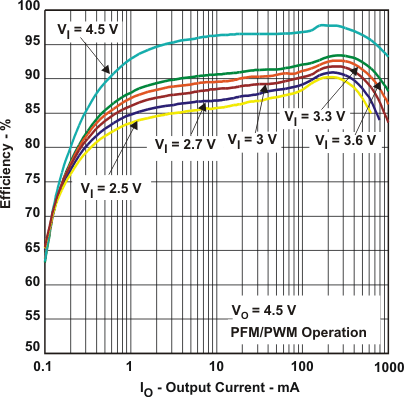 Figure 1. Efficiency vs Output Current
Figure 1. Efficiency vs Output Current
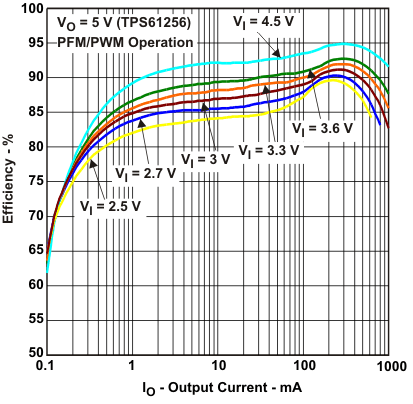 Figure 2. Efficiency vs Output Current
Figure 2. Efficiency vs Output Current
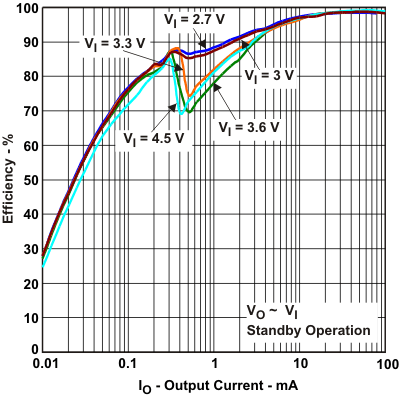 Figure 5. Efficiency vs Output Current
Figure 5. Efficiency vs Output Current
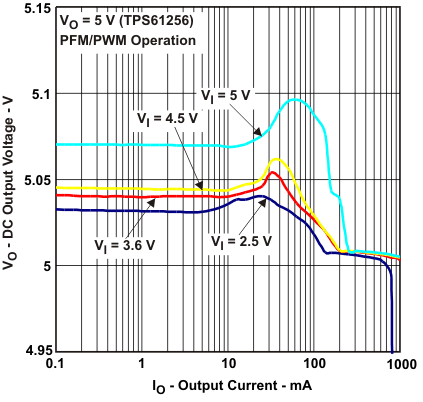 Figure 7. DC Output Voltage vs Output Current
Figure 7. DC Output Voltage vs Output Current
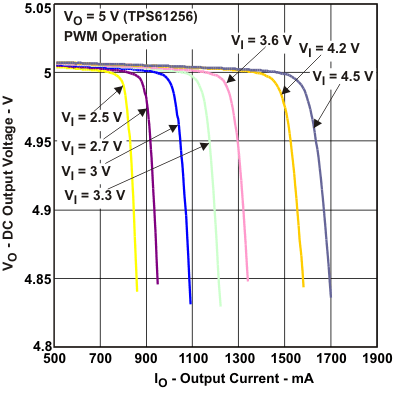 Figure 9. DC Output Voltage vs Output Current
Figure 9. DC Output Voltage vs Output Current
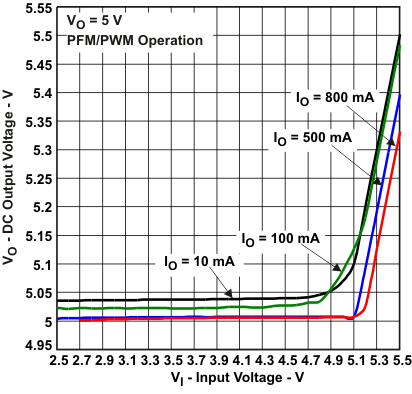 Figure 11. DC Output Voltage vs Input Voltage
Figure 11. DC Output Voltage vs Input Voltage
 Figure 13. Maximum Output Current vs Input Voltage
Figure 13. Maximum Output Current vs Input Voltage
 Figure 15. Peak-to-Peak Output Ripple Voltage vs Output Current
Figure 15. Peak-to-Peak Output Ripple Voltage vs Output Current
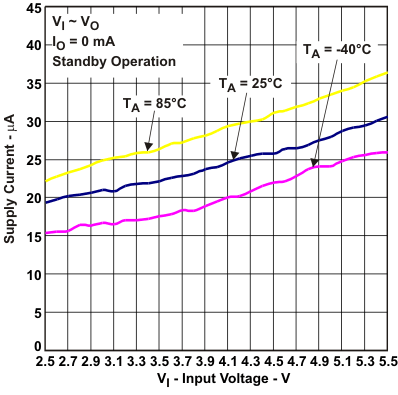 Figure 19. Supply Current vs Input Voltage
Figure 19. Supply Current vs Input Voltage
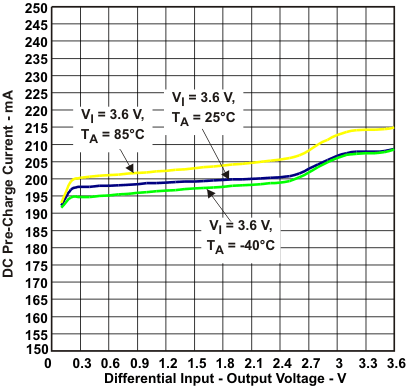 Figure 21. DC Pre-Charge Current vs Differential Input-Output Voltage
Figure 21. DC Pre-Charge Current vs Differential Input-Output Voltage
 Figure 4. Efficiency vs Input Voltage
Figure 4. Efficiency vs Input Voltage
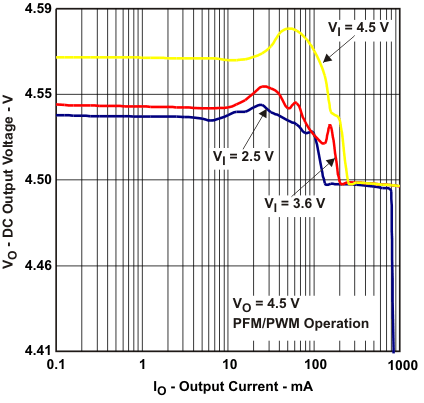 Figure 6. DC Output Voltage vs Output Current
Figure 6. DC Output Voltage vs Output Current
 Figure 8. DC Output Voltage vs Output Current
Figure 8. DC Output Voltage vs Output Current
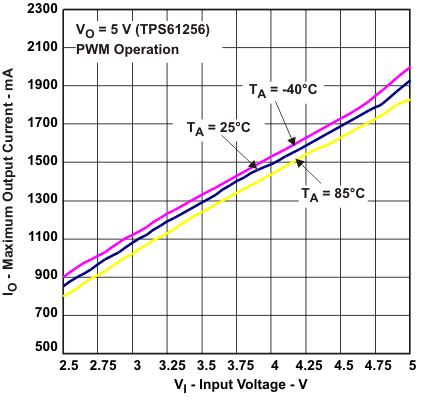 Figure 12. Maximum Output Current vs Input Voltage
Figure 12. Maximum Output Current vs Input Voltage
 Figure 14. DC Output Voltage vs Output Current
Figure 14. DC Output Voltage vs Output Current
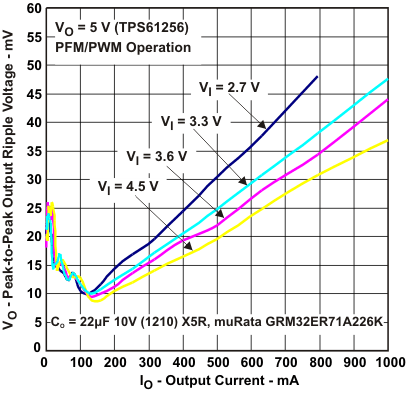 Figure 16. Peak-to-Peak Output Ripple Voltage vs Output Current
Figure 16. Peak-to-Peak Output Ripple Voltage vs Output Current
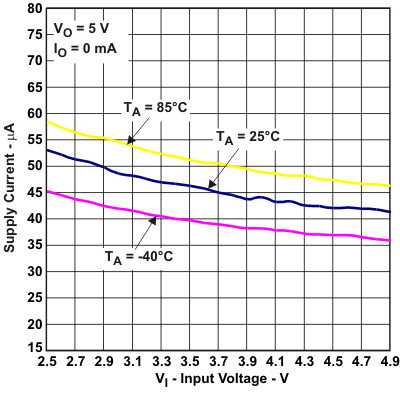 Figure 18. Supply Current vs Input Voltage
Figure 18. Supply Current vs Input Voltage
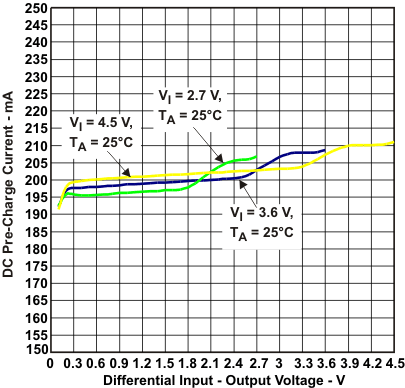 Figure 20. DC Pre-Charge Current vs Differential Input-Output Voltage
Figure 20. DC Pre-Charge Current vs Differential Input-Output Voltage
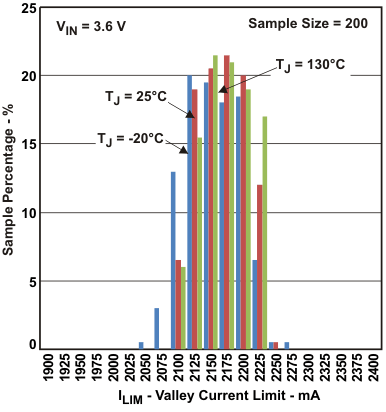 Figure 22. Valley Current Limit
Figure 22. Valley Current Limit
 Figure 24. MOSFET rDS(on) vs Temperature
Figure 24. MOSFET rDS(on) vs Temperature
8 Parameter Measurement Information
 Figure 25. Parameter Measurement Schematic
Figure 25. Parameter Measurement Schematic
